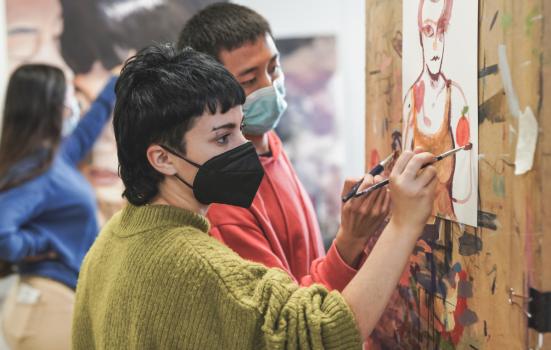New research that identifies how the pandemic heightened artists’ precarity highlights radically different perspectives for healthy arts ecologies in the future, writes Susan Jones.

Sabrina Bracher
An independent review demonstrating the pandemic’s severe impacts on the social and economic circumstances of visual artists reveals divergent perspectives at national and local levels in England about what artists and the arts are for and how future arts policy should be made and implemented.
Launched soon after the March 2020 lockdown, the DCMS inquiry into Covid’s impacts on all its sectors identified as an immediate concern the plight of arts freelancers whose work prospects melted away like snow on a sunny day. As Croydon Culture Network commented, artists’ personal resilience was knocked not only by loss of access to support networks but by the overbearing demand to rapidly build new sources of income.
Although they represent a sizeable section of human resource within the arts, many freelancers fell straight through government and arts safety nets, this due to poor knowledge of social demographics and their economic position within government and arts funding. Lack of understanding at policy level of artform particularities in income make-up made thousands of freelancers who were worthy of support ineligible for the government’s Job Retention Scheme (JRS) and Self-employed Income Support Scheme (SEISS).
Left to sink or swim
While only a third of musicians were ineligible to apply, among visual artists three-quarters were left to sink or swim because their self-employed earnings contributed less than half of annual earnings. Arts Council England’s (ACE) one-off competitive £2,500 emergency grants for individuals which reprised these inappropriate criteria further limited access to applicants with a track record of working in the publicly funded culture sector whose losses were directly attributed to Covid work cancellations.
To the detriment of the very many freelancers dependent on them for short-term and one-off work, arts organisations’ business models proved highly vulnerable to the pandemic’s successive shockwaves. Encouraged by government and funding policies, arts institutions commonly augment regular revenue funding with significant strands of commercially-derived income and philanthropic grants.
But pandemic circumstances colour-illustrated the baseline flaw in these neo-liberalist strategies, in that the more successful arts organisations had been at expanding trading and earned income strands and fundraising, the greater their financial problems in extreme conditions.
As Covid waned during the summer of 2022, institutions may have expected to win ‘more money’ in the next funding round to micro tune their leadership teams and beef up their business acumen to maintain their competitive position. But such aspirations are victim to a government now facing an enormous fiscal black hole with a poor track record for valuing public services including the arts.
Weakness of vertically framed arts ecologies
Failure of arts organisations’ ‘mixed income’ business model has long-term implications for freelance artists who are at greatest financial risk as their contracted work and associated fees fall outside organisations’ core operational costs and are dependent on running public programmes.
The weakness of the vertically framed arts ecologies concreted in by the last 40 years of arts policies lies in failure to recognise, value and capitalise on the assets of socially messy, dynamic interrelationships, unorthodox career paths and radical approaches to content origination. ACE’s preference for top down policy and trickle-down methodologies marginalises granular grassroots activities, including discounting the significance of individual visual artists’ nuanced, diverse contributions to their immediate communities and localities.
As shown by the framing of pandemic amelioration measures and since, the cohort of National Portfolio Organisations (NPOs) are the most important feature in ACE’s policy implementation.
ACE chief Darren Henley believes permanent institutions are best placed to “build prosperous places and strong, cohesive communities … attracting visitors, driving outside investment to local communities and creating jobs”.
Mutual flourishing
As direct challenge to ACE’s myopia as far as suitable infrastructures for the arts are concerned, many grassroots bodies and consortia provided the DCMS inquiry with an alternative, more expansive and inclusive vision. Although impacts of hyper-local arts and cultural ecologies may be less immediately visible and quantified, their strength lies in the mutual flourishing that is fostered and sustained over time.
As the Paul Hamlyn Foundation put it: “The arts ecology is delicate, and any support … must recognise the contribution of small, community, experimental and emerging practice as much as it does the drivers of economic growth – one does not exist without the other.” Arts recovery and long-term sustainability as a social good beyond the pandemic is dependent on celebrating and preserving regional, sub-regional and micro-level cultural nuance and variation.
This means future policies need to focus on shifting power, funding and economic accountability to the grassroots and small-scale. As sector support organisation Creative Kernow argued, it’s a strategy that, by acknowledging the strength of localised arts developments that “engage with audiences and networks to experiment in doing things differently …. creates inspirational blueprints for [other] communities”.
Levelling up
Inquiry responses from the cultural grassroots echoed calls from elsewhere - such as by Sleaford (LIPSIT) and Cooper (Fabian Society) - for systemic overhaul of cultural and economic norms as part of achieving societal levelling up. Redressing current levels of social exclusion and inequity rests on redistributing power, funding and economic accountability for the arts to the gregarious grassroots.
Broadening definitions of arts development and growth gives equal weight to markers for, and measurement of, the environmental, social and economic well-being of all making the arts, ensuring human flourishing through mutuality in devising and achieving social contribution and gain. By fostering nuanced, sustained interplay across micro and transient structures and larger-scale and permanent organisations, the bottom-up models revealed in these DCMS inquiry submissions equate resilience with provision of reciprocal, ‘caring’ conditions that foster good health and well-being amongst citizens.
According to Centre for Cultural Value’s substantial study of Covid affects, such conditions vitally provide for “sustainable development rather than unsustainable growth”. Importantly for artists’ futures, measuring the soft social benefits of their contributions to people’s places and lives over a life cycle counters the convenient misassumption often found among policymakers and arts managers that the artists livelihoods ‘problem’ lies in there being ‘too many’ for the work available, as if the current wastage of artists’ talents through manufactured scarcity is desirable and inevitable.
Dr Susan Jones is an independent arts researcher and specialist in artists’ livelihoods and visual arts policy matters.
![]() www.padwickjonesarts.co.uk
www.padwickjonesarts.co.uk
![]() @SusanJonesArts
@SusanJonesArts
This article is extracted from 'Cracking up: the pandemic effect on visual artists’ livelihoods' published in Cultural Trends, September 2022.




